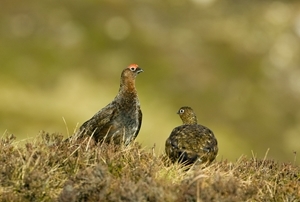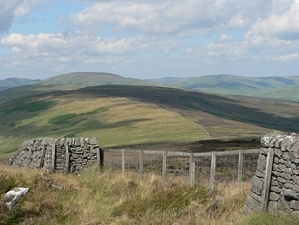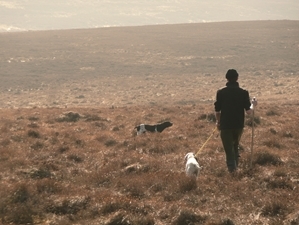Key points
- Long-term monitoring data on red grouse, their habitat, predators and management is invaluable for spotting trends in abundance and drivers of change.
- Population modelling within an adaptive management framework can help land managers understand what influences spring and autumn grouse abundance.
- Langholm Moor is a complex environment for red grouse. The weight of evidence suggests that weather, legal predator control, parasite load, hen harrier predation, and buzzard predation all affect grouse abundance.
Background
 Red grouse rely on heather-dominated moorlands for food, shelter, and reproduction. Their numbers can be influenced by predation, disease, poor weather, and parasites. Grouse moors are areas of heather moorland where gamekeepers manage red grouse for driven shooting. The management aims to produce a shootable surplus of birds through controlling predators, rejuvenating heather through cutting or burning, and medicating grouse against parasites.
Red grouse rely on heather-dominated moorlands for food, shelter, and reproduction. Their numbers can be influenced by predation, disease, poor weather, and parasites. Grouse moors are areas of heather moorland where gamekeepers manage red grouse for driven shooting. The management aims to produce a shootable surplus of birds through controlling predators, rejuvenating heather through cutting or burning, and medicating grouse against parasites.
Langholm Moor has been managed for sheep farming and red grouse shooting for over 100 years. Detailed monitoring of the grouse, their management, and their environment was carried out from 1992 to 2019. During this period the moor was managed for grouse (or ‘keepered’) between 1992-1999 and 2008-2016. At these times heather was burned and mowed, and non-protected predators such as foxes and carrion crows were legally culled. All raptors were fully protected, and diversionary feeding of hen harriers took place in 1998-1999 and 2008-2015 to reduce their predation of grouse. Sheep numbers were reduced in stages to alleviate grazing pressure and restore heather cover.
Environmental management, including that of grouse moors, requires land managers to make management decisions even though they may not fully understand how a system works. Adaptive management involves using the scientific process within decision-making, which allows land managers to learn about system responses and use that knowledge to help achieve their management objectives. This study used the principles of adaptive management to try and identify the key drivers of red grouse numbers at Langholm Moor.
What they did
 The study retrospectively looked at pre-breeding and post-breeding red grouse numbers at Langholm Moor in southwest Scotland between 1992 and 2019 using data from published, peer-reviewed, scientific papers. Information about the red grouse, predator numbers, parasite load, and heather cover was extracted from them. The data spanned 28 years, through keepered and unkeepered periods.
The study retrospectively looked at pre-breeding and post-breeding red grouse numbers at Langholm Moor in southwest Scotland between 1992 and 2019 using data from published, peer-reviewed, scientific papers. Information about the red grouse, predator numbers, parasite load, and heather cover was extracted from them. The data spanned 28 years, through keepered and unkeepered periods.
An essential part of the adaptive management approach involves two key phases:
- Creating simulation models that incorporate a variety of factors likely to drive population change.
- A monitoring programme to track inputs and outcomes.
The study constructed population simulation models, incorporating factors that could potentially have influenced red grouse numbers, looking at June temperature, annual parasite load, extent of heather habitat, legal control of non-protected predators, and raptor numbers. These factors were used as inputs in the models.
Using the inputs, the simulation models produce predictions that are compared statistically with real-life outcomes and weighted according to how accurate they are. Over time, models that make poor predictions are down-weighted while those that make good predictions gain weight. How the models are weighted can help to identify which factors have the biggest influence on outcomes.
The scientists also aimed to find out if both pre- and post-breeding grouse counts were needed for the models to work, or if one of the two provided enough data. Pre-breeding grouse counts were not possible in 2001, 2002 or 2019.
What they found
All grouse population models included parasite load and June temperature as a baseline. When no other factors were included, or when just heather cover was included, the predicted grouse numbers underestimated the actual counts. It remained this way irrespective of whether pre-breeding, post-breeding, or both sets of grouse count data were used.
In contrast, when legal predator control was added to the previous models, the predicted grouse numbers were higher than were actually recorded, especially during keepered periods. These models were not well supported, regardless of whether they used pre- or post-breeding grouse data, or both.
Instead, models investigating the impact of legal predator control in combination with raptors – with or without heather cover – were better supported. These models predicted grouse numbers that were much closer to the real-life grouse counts. When pre- and post-breeding grouse data were used, a model with hen harrier impacts alone overestimated grouse numbers during the second keepered period; a model with hen harrier, buzzard and habitat effects underestimated grouse numbers. An intermediate model involving hen harrier and buzzard effects provided predictions that came closest to the observed data, correcting the under- and overestimation seen in other models.
What does this mean?
 The study highlighted that there was not a substantial difference in the predictions given by using pre- or post-breeding grouse data, or a combination of the two. Although using both data sets helped to reduce variability in predictions, using just pre-breeding or post-breeding grouse data was sufficient.
The study highlighted that there was not a substantial difference in the predictions given by using pre- or post-breeding grouse data, or a combination of the two. Although using both data sets helped to reduce variability in predictions, using just pre-breeding or post-breeding grouse data was sufficient.
The study also found that complicated models performed better than simpler ones. More complex models were able to predict grouse numbers that were close to real-life counts. This tells us that Langholm Moor is a complex environment for red grouse, influenced by multiple factors at any given time. It also became clear that different factors affected grouse densities at different times, owing to the management of the site and changes in predator species composition and abundance.
The long-term nature of the study allowed influential factors to be identified where previous studies had not done so. This included the impact of buzzards. The weight of evidence from the adaptive management modelling was strongly in favour of buzzards as active grouse predators rather than just scavengers.
The adaptive management approach allowed the least influential factors to be identified after the first five years. However, an additional 15 years of data were needed to determine the most critical influences. For example, heather cover was believed to be an important factor affecting grouse numbers. The adaptive management modelling found that, although it may have played a role between 1998 and 2005 when no keepering took place, its influence over the full 28-year period was not as important as previously thought. The most successful models suggest that, at Langholm Moor, combinations of parasite load, weather, legal predator control, and numbers of hen harriers and buzzards had the most influence on grouse numbers.
Read the original paper
Powell, Larkin A., Aebischer, Nicholas J., Ludwig, Sonja C., and Baines, David, 2022. Retrospective Comparisons of Competing Demographic Models Give Clarity from “Messy” Management on a Scottish Grouse Moor. Ecological Applications e2680.